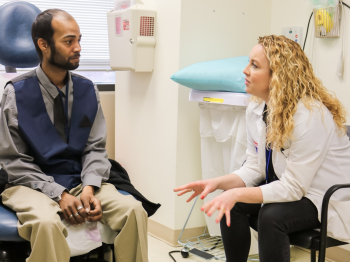Differences in cancer outcomes vary widely in local and global populations based on interrelated and interwoven socioeconomic factors, race/ethnicity and geographic location. Primary causes for health disparities are limited access to care, particularly screening and diagnosis, as well as challenges in implementing increasingly complex treatment modalities in low-resource settings. However, other factors, including disease predispositions and differential responses to standard of care contribute as well.
CCR is dedicated to conducting research to eliminate cancer health disparities through basic, translational, and clinical research. Our investigators who conduct this research are committed to understanding the biological underpinnings that contribute to differing cancer outcomes observed in different populations.
CCR has a long history of identifying new therapeutic targets and translating these basic research discoveries into the clinic. We continue to use this expertise to develop new treatments that benefit everyone.
Some of the current research areas in CCR focused on cancer health disparities include:
Breast Cancer
On average, African American women in the US are younger at diagnosis, more likely to be diagnosed with more advanced forms, and more likely to die of breast cancer compared to white women. African American women also experience a higher incidence of aggressive triple-negative breast cancer compared to women of other racial and ethnic groups.
- Investigators in CCR’s Cancer Innovation Laboratory have identified elevated levels of a protein called gp78 in African American women with breast cancer, which correlated with worse outcomes and may help explain the disparity in survival outcomes between African American and European American women.
- CCR’s Laboratory of Human Carcinogenesis is examining how comorbidities, the neighborhood environment, the immune microenvironment and various known breast cancer risk factors influence tumor and normal breast tissue biology in African American and European American women. This research identifies potential differences in the immune response and epigenome among breast cancer patients of different social or ethnic backgrounds and how environmental factors may contribute to these differences.
- CCR investigators are also trying to understand why younger women with breast cancer, especially African American women, often experience more aggressive disease. Previous research by members of the Women’s Malignancies Branch has revealed that age-related differences in the immune system may predispose younger women with breast cancer to brain metastasis compared to older women.
Liver Cancer
American Indians, Hispanics, Alaskan Natives, Asian Americans and Pacific Islanders have higher rates of liver cancer compared to other racial and ethnic groups. In addition, disadvantaged populations, specifically racial and ethnic minorities, and individuals of low socioeconomic status exhibit both higher rates of hepatocellular carcinoma, a common type of liver cancer, and worse survival.
Investigators in the Liver Cancer Program at CCR are working to identify genetic signatures for early detection and diagnosis of liver cancer, as well as biomarkers that could identify those patients with the highest risk of metastatic disease.
A novel screening method developed by members of CCR’s Laboratory of Human Carcinogenesis, based on the detection of antibodies indicative of prior viral exposures, enables improved prediction and earlier diagnosis of individuals with hepatocellular carcinoma.
Lung Cancer
Compared to other racial and ethnic groups in the United States, African Americans have a higher incidence of lung cancer, worse survival, and are more likely to develop the disease at a younger age.
Investigators in CCR’s Laboratory of Human Carcinogenesis (LHC) are investigating potential cancer biomarkers that could improve the diagnosis and treatment of lung cancer.
Previous work by LHC investigators revealed differences in DNA damage repair between African Americans and European Americans that may contribute to disparities in lung cancer incidence and survival.
Prostate Cancer
The incidence of prostate cancer is higher among African American men compared to other racial and ethnic groups. African American men are also more than twice as likely to die of prostate cancer than white men.
Investigators in CCR’s Laboratory of Human Carcinogenesis are identifying the environmental and genetic factors that contribute to the differences in prostate cancer incidence and mortality between African American and European American men, as well as the role of environmentally induced inflammation in prostate cancer progression.
Clinical trials, led by members of the Molecular Imaging Branch, will be testing new imaging methods for diagnosing prostate cancer in African American men, which could lead to earlier diagnosis and better outcomes.
Previous studies at CCR revealed differences in the tumor microenvironment between African American and European American men, with the former exhibiting an immune-inflammation signature, and determined that aspirin use significantly reduced the risk of aggressive prostate cancer in African Americans.
Other studies in CCR’s Genitourinary Malignancies Branch are identifying biomarkers that correlate with increased prostate cancer risk and ways to predict how an individual’s cancer will respond to treatment.
HIV
HIV disproportionately affects African American and Latinx communities and there is a significant disparity in HIV outcomes for African Americans compared to white Americans.
Current research in the CCR HIV Dynamics and Replication Program is aimed at understanding how HIV persists and continues to replicate in individuals undergoing combination antiretroviral therapy (ART), identifying new targets for treatment and eradication of HIV infection.
Significant racial disparities exist in the incidence of Kaposi sarcoma. Investigators in the HIV and AIDS Malignancies Branch are working to identify targeted therapies for Kaposi sarcoma and Castleman disease, approaches that have greatly improved outcomes for many other cancer types but that are not currently available for AIDS-associated malignancies.
HPV
HPV infection is the cause of the vast majority of cervical cancers. African American and Hispanic women are much more likely to develop cervical cancer than white women. Although HPV vaccination can reduce the risk of HPV-associated cancers, African American and Hispanic individuals, individuals living in rural areas and those with low socioeconomic status are less likely to complete HPV immunization and gain protection for HPV-related cancers.
Investigators from CCR’s Laboratory of Cellular Oncology were instrumental in the development of currently approved HPV vaccines and are currently working to develop vaccines against HPV35-associated cervical cancer, for which women of African ancestry have increased susceptibility.
Several clinical trials, led by investigators in the Center for Immuno-Oncology, are underway to investigate the use of immunotherapy and cellular therapy in cancers and premalignant diseases caused by chronic HPV infection.
Low-Cost Cancer Treatments
Current research trends for new cancer therapies have continued to focus on precision medicine, resulting in increasingly individualized and costly treatment regimens that continue to widen disparities in access to care. CCR investigators are also focused on identifying simple, inexpensive cancer treatment strategies that can be easily used in low resource areas to reduce disparities in access to care.
Investigators from CCR’s Laboratory of Cellular Oncology have developed a promising treatment strategy capitalizing on the high prevalence of a common viral infection to activate an individual’s own immune system to fight cancer. Preliminary evidence suggests that this strategy could be effective for several different tumor types.



